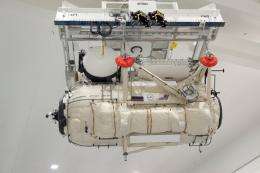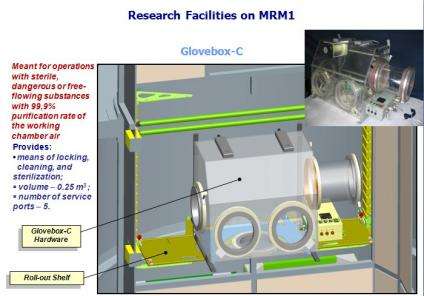A New 'Dawn' in Space

(PhysOrg.com) -- A Russian-built Mini-Research Module-1 launched on space shuttle Atlantis' STS-132 mission May 14.
There's a new "dawn" for science experiments aboard the International Space Station.
A Russian-built Mini-Research Module-1 launched on space shuttle Atlantis' STS-132 mission May 14. The module, known as Rassvet -- which translates as "dawn" -- will be used for science research and cargo storage. It also will provide an additional docking port for Russian Soyuz and Progress vehicles at the space station.
Weighing more than 11,000 pounds and measuring 19.7 feet in length and 7.7 feet in diameter, Rassvet will host a wide variety of biotechnology and biological science experiments and fluid physics and educational research.
The module contains a pressurized compartment with eight workstations equipped with facilities such as a glovebox to keep experiments separated from the in-cabin environment; two incubators to accommodate high- and low-temperature experiments; and a vibroprotective platform to protect payloads and experiments from onboard vibrations. The module contains four other workstations, complete with mechanical adapters, to install payloads into roll-out racks and shelves.
"Our science capabilities are going to be greater than ever on the space station," said Igor Sorokin, deputy head of the Space Station Utilization Center at S.P. Korolev Rocket and Space Corporation Energia. "From the standpoint of science capabilities to be provided, as well as payload integration principles to be applied, this module can be considered as an intermediate one -- even in its "mini" version -- between the older Russian Service Module and future Multipurpose Laboratory Module, which is targeted for the station in 2012. We have applied some advanced principles of research facilities development and integration as compared with the Service Module, which will increase the utilization efficiency of the Russian segment."

Some benefits include conducting experiments such as Conjugation, which studies the exchange of genetic material in microgravity to develop strains producing new target proteins to fight disease. Another experiment, Kristallizator, allows large protein crystals to grow in orbit to better determine their 3-D structure. The results could be used in biology, medicine and pharmacology.
"Rassvet provides important new real estate for experiments to be conducted on the space station, and will be a cornerstone of Russian laboratory facilities for years to come," said Julie Robinson, International Space Station program scientist at Johnson Space Center in Houston. "This new module enhances the station's research capabilities and enables new investigations to be performed."
Rassvet was developed at S.P. Korolev Rocket and Space Corporation Energia in Russia.
Provided by JPL/NASA


















